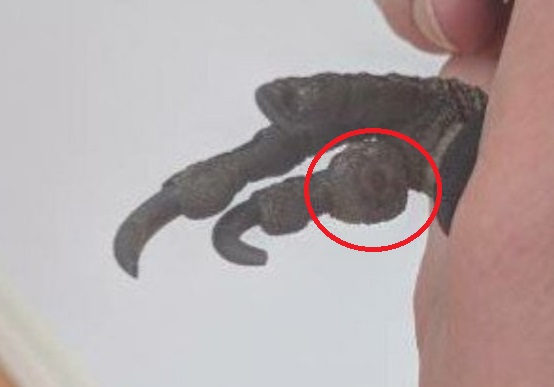| Guide | Treatment of light cases of Bumblefoot (Pododermatitis) |
| Target Group | Corvids |
| Author | helpthecrows@gmail.com |
| Version | 20221105 |
| NOTE: In all my guides, I start from a situation where a rehabilitator takes his responsibility to take care of the animals in an ethically correct way. You should always try to minimize stress for the bird and since the birds, just like humans, are not the same, it can mean that you handle a problem in different ways by being creative! If I see different ways of doing the same thing, I try to write it down in my guides, but it is always up to the rehabilitator to take their own responsibility. I do not have to write “I recommend putting the bird down” or “contact a veterinarian” or “according to law, you should …” because I start from the situation where you do the best for the bird and that you as a rehabilitator have learned to draw the line so that you do not end up in an unwanted or illegal situation. There may be an eternal battle between what you want and what is best for the bird. There are also many factors where a similar situation can give different results. For example: access to a veterinarian, lack of time, lack of knowledge and previous experience can include cause large differences in the treatment and decision-making process and indirectly also the end result. Knowledge of basic things can make a huge difference in the stress level of the crow. For example. avoid anything that is black or checkered. They do not like it instinctively and it creates stress when they see that you are dealing with something that is black. I put energy into my guides to make it easier for a rehabilitator to find information and to spread knowledge. Do you see a way to improve my guides or do you see a mistake or do you want to add something, feel free to inform me! If you are worried about doing something because it is new, ask other rehabilitators or a veterinarian for help. The guides are continuously updated, so make sure to always download the latest version from www.corvidlove.com |
This guide describes what to do with birds that have gotten Bumblefoot
What is Bumblefoot?
Bumblefoot is a bird disease caused by staphylococci.
Staphylococcus is a common bacterium that has had a chance to enter the body when the bird gets a soar.
Mild cases can be solved by following this guide
NOTE: Difficult cases can NOT be solved. Use the second guide on this website!
Cause and spread
The cause of the problem is usually that a little pressure soar has formed on the foot. Just like in humans, the skin does not tolerate being exposed in the same place for a long period of time. So if a bird has been sitting on an inappropriate branch or received a wound on the foot, staphylococci can find a way to get into the body and then the suffering for the bird begins.
Symptoms:
Visible sores that are almost always present under the foot. Sometimes it becomes so infected and it swells up so badly that it can also be seen on the top of the foot.

Treatment, medicine and dosage:
Without treatment, a crow can die from the infection. It spreads throughout the body.
There are various products you need to get hold of to treat Bumblefoot effectively.
A veterinarian needs to prescribe Baytril (broad spectrum antibiotics) to kill the bacteria.
The wound itself should also be treated. You should not open the wound. The reason is that you can not clean it clinically and that it hurts. If it is really bad, it is best for a veterinarian to do it surgically.
The wound should be washed twice a day with diluted Hibiscrub. Hibiscrub is available at your pharmacy and Amazon:
https://www.amazon.co.uk/s?k=Hibiscrub-Health-Care-500-ml
Take 1 dose of Hibiscrub and at least three times as much water.
On the packaging it may say that it is to be used undiluted, but for small animals you have to dilute!

After the wound has been cleaned, you can lubricate it with F10 Ointment or Manuka honey (natural product that you buy at the pharmacy!).
Do not forget that you also have to kill the bacteria on the branch / perch. If possible, the stick should be boiled. Otherwise you can use Chlorhexidine spray.
F10 Ointment works best! Available on Amazon: https://www.amazon.co.uk/s?k=f10+ointment

Continue the treatment for at least 7-10 days (this is usually as long as the antibiotic treatment lasts, and take the opportunity to take care of the foot when you have caught the bird anyway).
Important addition!
A crow bird that has Bumblefoot should preferably have a soft surface to sit on. Since a branch, on which they usually sit, is not soft, you need to make it softer with the help of a soft doormat. The easiest way is to cut a strip from a soft rug and fasten it around the crotch with the help of cable ties.
You can buy a doormat cheapest at Ikea , only 1,5 GBP 🙂 https://www.ikea.com/gb/en/search/products/?q=kristrup
You can buy something else but it has to feel a bit like padded fabric.
Whatever you buy, make sure that it is not plastic that they can tear off pieces from and eat.
